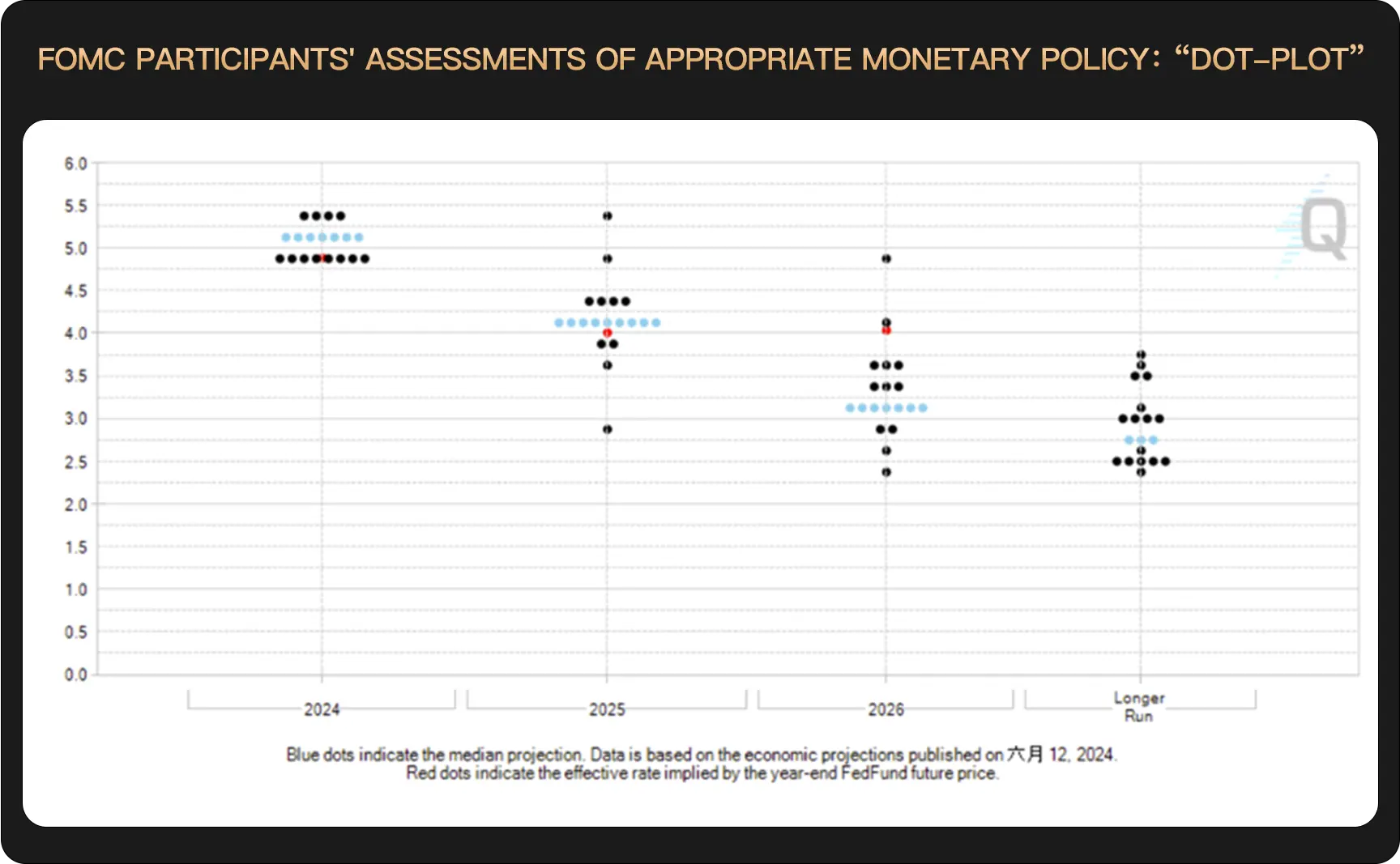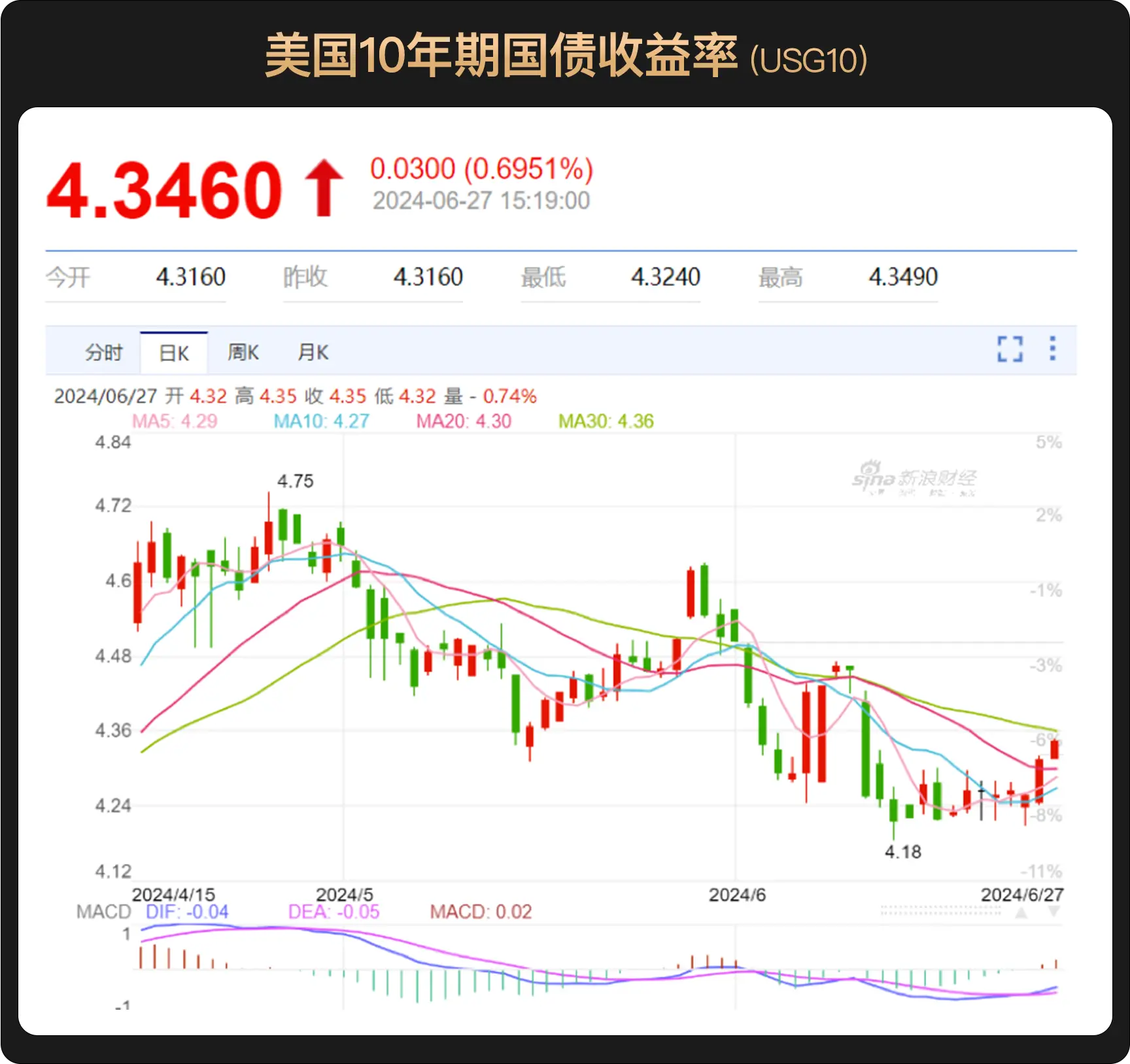WealthBee Macro Monthly Report: Controversy Over Fed Rate Cuts Sparks New Investment Opportunities in the Crypto Market

The divergence between the U.S. June CPI and non-farm data has led to a lack of consensus in the market regarding the number of interest rate cuts, leaving investors to "watch and wait." Nvidia's market capitalization briefly soared to become the largest in the world, becoming a pride of the AI era. However, the U.S. stock market is severely polarized, with high price-to-earnings ratios indicating that a bubble is already apparent. The cryptocurrency market has experienced an inexplicable decline this month, with selling pressure from old OGs and miners possibly being the direct cause of the drop, also providing new investment opportunities for the future.

The latest FOMC meeting in the U.S. concluded in June, deciding to maintain the federal funds rate between 5.25% and 5.50%, a decision that aligns with market expectations. However, the overall tone of this FOMC meeting was dovish, a departure from the previous hawkish stance. In the meeting's wording, Powell noted that current inflation has made "moderate progress" toward the 2% target. Indeed, the latest CPI data for May shows that the U.S. CPI rose 3.3% year-on-year, slightly down from the previous and expected values of 3.4%; the core CPI, excluding food and energy costs, rose 3.4% year-on-year, below the expected 3.5% and the previous value of 3.6%, marking the lowest level in over three years.
However, despite the favorable inflation data, the performance of non-farm data casts a shadow over the prospect of interest rate cuts. The U.S. non-farm employment for May was 272,000 (expected 185,000, previous value 175,000), exceeding Wall Street analysts' predictions. This divergence between inflation and employment data has led to a lack of consensus in the market regarding the timing and number of interest rate cuts. The FedWatch Tool indicates that the probability of a first rate cut in September is currently only 56.3%.

The dot plot shows that 11 members believe that interest rates will remain above 5% this year, implying at most only one rate cut; 8 members believe it could drop to 4.75% - 5%, implying two rate cuts. Therefore, there is currently no clear conclusion regarding the number and magnitude of rate cuts, and investors can only "watch and wait."

From a trading perspective, the market seems to have begun betting on a rate cut by the Federal Reserve. U.S. Treasury yields have been on a downward trend in recent months.

Gold prices are also showing a high-level consolidation, which seems to indicate that the risk appetite of funds is gradually increasing, while the appeal of safe-haven assets is decreasing.

Currently, U.S. inflation appears to be moving in the right direction. The latest Markit Manufacturing PMI for the U.S. is 51.7 (expected 51.0, previous value 51.3); the Atlanta Federal Reserve's GDPNow model forecasts a GDP growth rate of 3.0% for the second quarter of 2024. Therefore, WealthBee believes that investors need not worry too much about the U.S. economy and can simply wait for inflation to fall and for the Federal Reserve to cut rates.

On June 18, Nvidia (NVDA) shares rose 3.51%, bringing its market capitalization to $333.53 billion, surpassing Microsoft and Apple to become the largest company in the world by market cap. This occurred less than two weeks after Nvidia's market cap exceeded Apple's on June 5, joining the $3 trillion market cap club. Undoubtedly, in this narrative of disruptive AI transformation, Nvidia has reaped significant benefits, becoming a market darling voted by real money.

However, after Nvidia's brief ascent to the top, Jensen Huang began to reduce his holdings and cash out, leading to a subsequent pullback in the stock price. It has now returned to third place behind Microsoft and Apple.
The Federal Reserve has yet to cut rates, but the U.S. stock market continues to set historical highs, driven by the strong momentum from the AI narrative, breaking the macroeconomic cycle and creating an independent market trend. This month, the Nasdaq and S&P 500 continued to reach historical highs, while the Dow Jones remained in a high-level consolidation.
Since the beginning of the year, discussions about a "U.S. stock market bubble" have been increasingly loud, yet the market keeps setting new highs. If WealthBee analyzes from the price-to-earnings ratio perspective, although the S&P 500's P/E ratio has been rising over the past year and is close to the 80th percentile since the 21st century, it is still much lower than the P/E ratio during the burst of the internet bubble around 2002. Therefore, it can be said that a bubble does exist, but it is not as severe.

However, this month, the difference between the S&P 500 index return and breadth indicator reached a 30-year extreme, indicating that despite the index setting new highs, the number of rising stocks is continuously decreasing. This suggests that market funds are concentrated entirely in large-cap stocks, while small-cap stocks are almost "ignored." This phenomenon is not conducive to the overall liquidity of the U.S. stock market, and institutional clustering may lead to a sharp decline in the entire market if the clustered stocks fall. Therefore, the current risks in the U.S. stock market are evident. WealthBee believes that we may need to wait for Nvidia's Q2 fiscal report for 2025 to see if Nvidia can continue to exceed market expectations, combined with changes in rate cut expectations, which may lead to some changes in U.S. stock market styles.
Aside from the U.S. stock market, the Asia-Pacific market has also performed well this month, with the Mumbai SENSEX approaching 80,000 points and the Taiwan Weighted Index reaching a historical high. Despite the yen exchange rate falling below 160, the Nikkei 225 remains strong in high-level consolidation.

While U.S. stocks are hitting new highs, the cryptocurrency market has inexplicably declined. This month, despite no apparent macroeconomic headwinds, the cryptocurrency market has continued to fall, with Bitcoin dropping below $58,500 and Ethereum falling to around $3,240.
In fact, the macroeconomic environment throughout June has been quite good, and the Federal Reserve's statements have turned dovish. However, financial market fluctuations are often difficult to explain. According to monitoring data from HOD L1 5 Capital, in June, the U.S. spot Bitcoin ETF still saw a net inflow of 9,281 BTC, indicating a net inflow status for the Bitcoin spot ETF, while the market trend contradicts the actions of large institutions.

Currently, the direct cause of the market decline is still attributed to the selling pressure from old OGs and miners (for example, miners and whales have sold off $4.1 billion). As for why there has been concentrated selling during this period, it is likely just "coming together for no reason."

From another perspective, the emergence of a large number of financial instruments in the Bitcoin market has also greatly increased market volatility. Since the introduction of Bitcoin futures trading in 2017, an increasing number of complex financial derivatives have been born. Without futures trading, if everyone were trading spot freely in the market, then aside from the supply increase caused by miners producing new Bitcoins, all other trades would be neutral. The emergence of futures has led to naked short selling in the market, resulting in a large amount of "paper BTC," thus increasing market supply and exacerbating Bitcoin price volatility. The intertwining of spot, futures, options, and other financial instruments has made the entire Bitcoin market's volatility increasingly chaotic, and the simple and beautiful "classical era" of Bitcoin is gone forever.
Since there are no obvious risks present, the decline is likely a good opportunity to add positions, and the selling by whales also provides other investors with a chance to enter at lower prices.
Moreover, the increasing diversification of financial instruments is a key pathway for the cryptocurrency market to gradually enter the public eye. This month, the cryptocurrency market welcomed two important pieces of news. First, the arrival of the Ethereum spot ETF is expected to be faster than anticipated, possibly being approved as early as early July. Bloomberg ETF analyst Eric Balchunas expects the Ethereum spot ETF to be approved as early as July 2.

Additionally, on June 27, VanEck's head of digital asset research, Matthew Sigel, announced that they have applied to the SEC for a Solana ETF, which may be launched in 2025.

From Bitcoin to Ethereum, and from Ethereum to Solana, crypto assets are being accepted by traditional markets at an unexpectedly rapid pace, and the incremental funds generated will likely be immeasurable.

Although the U.S. June CPI data shows that inflation has unexpectedly cooled, the strong performance of non-farm data complicates the market's expectations for the Federal Reserve's rate cuts. Furthermore, the divergence between CPI and non-farm data, along with the rate cuts already initiated in Europe, further exacerbates the differentiation of global monetary policies. In the stock market, the dramatic fluctuations in Nvidia's market cap and the divergence between large and small U.S. stocks reflect the market's varying outlook on AI technology, while also exposing the increasing concentration in the market.
This month, the significant drop in Bitcoin prices in the cryptocurrency market below $60,000, along with the decoupling from U.S. stock trends, may be related to the selling behavior of miners and long-term holders. The increased volatility in the market may partly be due to the emergence of complex financial derivatives related to Bitcoin. Nevertheless, the launch of spot ETFs is seen as a stabilizer for the market, providing investors with hedging tools. In particular, the anticipated launch of the Ethereum spot ETF in early July is expected to bring new vitality and stability to the market. Despite the uncertainties in the macroeconomic and traditional financial markets, the cryptocurrency asset market demonstrates its independence and resilience, likely playing an increasingly important role in diversified investment portfolios and providing new growth opportunities for investors.










